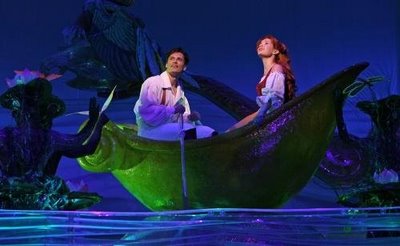“In most of mankind gratitude is merely a secret hope of further favors.”
La Rochefoucauld, Sentences et Maximes Morales
Archives for January 2008
CAAF: Afternoon coffee
• Timothy Wu makes a convincing case for why J.K. Rowling should lose her copyright lawsuit against the Harry Potter Lexicon.
• It’s always difficult to resist a scandal in the romance world. It’s even harder when said scandal centers on (possibly) purloined phrases relating to the habits and hard times of “black-footed ferrets.” (Via.)
CAAF: Video stars and literary getaways
For your afternoon viewing pleasure, two troves of author videos:
• The Exhibit X archives features recordings of former guests of the series, including Samuel R. Delany (!), Rikki Ducornet, Lydia Davis, Kathryn Davis and several other great authors.
• Along with word of a possible new DFW novel in the offing, The Millions points the way to video of Wallace at Capri’s Le Conversazioni festival in 2006. Pay attention when the camera pans through the crowd, you can see Lindsay Lohan making out with some Italian dude in the back row. Also on the Conversazioni site are readings and conversations with Zadie Smith, Nathan Englander, Martin Amis, and many others with flourishing royalty statements.
As no doubt you’ve noticed, literary festivals are getting very glamorous these days, with locations like Capri, a glass cave underneath a volcano in Mexico… Brooklyn. Still, none of these has caught my fancy as much as a literary getaway idea Maud floated a couple years back: Fishing trips with James Hynes. She was speaking lightheartedly but I think it’s a lovely idea. $250 bucks and you get to spend the afternoon on Town Lake in Austin, shooting the breeze with Hynes and drinking Pearl from a cooler. Get anything published in the next year and the whole afternoon’s tax-deductible. (Hynes may be alarmed at the prospect but he should bear in mind: a) no prepared remarks would be expected, and b) he could probably fit up to eight people in the boat.)
TT: Fish tale
In today’s Wall Street Journal drama column I return to New York to review two shows which could scarcely be more different, Disney’s The Little Mermaid and Samuel Beckett’s Happy Days. Here’s a sample.
* * *
Rumors of doom have stalked “The Little Mermaid” ever since its Denver tryout last August, and the whispers grew louder as it swam toward Broadway. So let me start off by answering the big question: The new Disney musical is a charmer. No, it’s not “Return of the Lion King,” but “The Little Mermaid” passes the ooh-and-aah test with plenty of room to spare. Unlike the inexplicably grumpy “Mary Poppins,” “Mermaid” is both visually ingenious and emotionally satisfying, and I expect it to run from here to eternity and back again.
 Based on the much-loved 1989 animated feature that breathed new life into the cartoon trade, “The Little Mermaid” is a sugar-sparkled retelling of Hans Christian Andersen’s darkly ironic fairy tale about a mermaid with a wandering eye who falls for a human prince and trades her tail and voice for a pair of legs so that she can woo him. In the Disney version, Ariel (Sierra Boggess) gets the guy (Sean Palmer) and lives happily ever after, though not before running afoul of Ursula (Sherie Rene Scott), a scene-stealing octopus who collects “poor unfortunate souls” and wants to put Ariel’s on her shelf.
Based on the much-loved 1989 animated feature that breathed new life into the cartoon trade, “The Little Mermaid” is a sugar-sparkled retelling of Hans Christian Andersen’s darkly ironic fairy tale about a mermaid with a wandering eye who falls for a human prince and trades her tail and voice for a pair of legs so that she can woo him. In the Disney version, Ariel (Sierra Boggess) gets the guy (Sean Palmer) and lives happily ever after, though not before running afoul of Ursula (Sherie Rene Scott), a scene-stealing octopus who collects “poor unfortunate souls” and wants to put Ariel’s on her shelf.
All this is vastly easier to tell–or draw–than it is to put on stage. To start with, how do you turn that stage into a seaful of swimming fish? Choreographer Stephen Mear solved part of the problem by equipping the underwater members of the cast with Heelys, the popular sneakers with wheels built into the heels, thus allowing them to glide instead of walking. Add to this the long-finned costumes of Tatiana Noginova, the fantastically elaborate sets of George Tsypin and the subaqueous rear projections of Sven Ortel and you get a nonliteral evocation of marine life that is not merely plausible but downright uncanny. Forget the kids: I oohed and aahed like a six-year-old as Ariel floated upward to the ocean’s surface and turned into a human….
 Written in 1961, “Happy Days” is among the starkest of Samuel Beckett’s theatrical parables about the human condition. Despite its author’s reputation for impenetrability, the symbolism of this two-hander is as intelligible as a kidney punch. The first act is a near-monologue by Winnie (Fiona Shaw), a woman of a certain age who is buried up to her waist in a mound of dirt. Willie (Tim Potter), her husband and audience of one, is a half-demented older man who leaves most of the talking to Winnie. In the second act Winnie is buried up to her chin and Willie is reduced to grunting…
Written in 1961, “Happy Days” is among the starkest of Samuel Beckett’s theatrical parables about the human condition. Despite its author’s reputation for impenetrability, the symbolism of this two-hander is as intelligible as a kidney punch. The first act is a near-monologue by Winnie (Fiona Shaw), a woman of a certain age who is buried up to her waist in a mound of dirt. Willie (Tim Potter), her husband and audience of one, is a half-demented older man who leaves most of the talking to Winnie. In the second act Winnie is buried up to her chin and Willie is reduced to grunting…
Beckett leaves it up to the viewer to draw his own conclusions about the meaning of “Happy Days.” I wish Deborah Warner, the director, had been as willing to leave its symbols completely open, but instead she has ignored the stage directions and set the play in the middle of what looks rather too much like a building that has been leveled by a bomb. (Cliché! Cliché!) Ms. Shaw’s interpretation of the first act is similarly over-explicit–she treats Beckett’s chiseled lines like a series of acting exercises–but once her torso is buried under the rubble, forcing her to act with her voice and face alone, she snaps into tight focus and escorts us to the edge of the abyss….
* * *
Read the whole thing here.
TT: Almanac
“We grow tired of everything but turning others into ridicule, and congratulating ourselves on their defects.”
William Hazlitt, “On the Pleasure of Hating”
OGIC: Double feature
There Will Be Blood and The Diving Bell and the Butterfly each begin by taking us somewhere most moviegoers, and indeed the people who made these films, could otherwise only imagine: Blood to the depths of a nineteenth-century silver mine, Diving Bell behind the eyes of a paralyzed patient regaining consciousness after three weeks spent in a coma. In both cases I found myself conscious of and a little awed by the flights of imagination required to stage and film these scenes–the surmise that was necessarily involved to answer the question “What must it have been like?”, not to mention the technical ingenuity (this piece in the Times last weekend on the production designer for Blood is illuminating on this point). And in both opening sequences space, vision, and movement are radically restricted so that we experience the passage into the rest of the movie as a widening of the given world–before it ultimately, inexorably narrows again.
I don’t think there is a lot that connects these very different movies, but I was struck in each instance by a sense of sharing or seeing a foreign experience, one unavailable outside the movie house or the imagination. Seeing these movies in the same twenty-four hours was not necessarily my brightest idea ever: they both have powerful, distinctive visions that demand their own space in which to be absorbed and appreciated. In their own singular ways, they each have a hallucinatory quality and a series of indelible images. For me, the experience of Paul Thomas Anderson’s booming, declamatory movie on Saturday overwhelmed the equally spectacular, but infinitely more delicate, sensual spectacle of Julian Schnabel’s, which I saw at a Sunday matinee.
Still, it was better to have these two bump up against one another than to miss either one. They were among the very best 2007 releases I saw. I left Blood uncertain of what it was really about–greed? capitalism? capitalism and evangelism? obsessive ambition?–and I remain unmoved by any of the answers put forward in reviews I’ve read or conversations I’ve had, while remaining tremendously moved by the movie–especially any scene in which Daniel Day-Lewis’s character, Daniel Plainview, wants something. The Diving Bell I might need to see again to fully grasp its beauty and its sharp irony: as seen, heard, and felt by a trapped and hungry mind, this world is an outrageously plenteous place.
CAAF: “Why, Miss Strunk… you’re beautiful.”
On this week’s Savage Lovecast, Dan fields a call from the befuddled boyfriend of a grammar nerd who likes to play out the usage wars in the bedroom (call begins at 31:50). NSFW, but enjoyable for anyone who’s ever loved a copy editor.
TT: So you want to see a show?
Here’s my list of recommended Broadway, off-Broadway, and out-of-town shows, updated weekly. In all cases, I gave these shows favorable reviews in The Wall Street Journal when they opened. For more information, click on the title.
Warning: Broadway shows marked with an asterisk were sold out, or nearly so, last week.
BROADWAY:
• August: Osage County (drama, R, adult subject matter, closes Mar. 9, reviewed here)
• Avenue Q * (musical, R, adult subject matter and one show-stopping scene of puppet-on-puppet sex, reviewed here)
• A Chorus Line * (musical, PG-13/R, adult subject matter, reviewed here)
• The Farnsworth Invention (drama, PG-13, reviewed here)
• Grease * (musical, PG-13, some sexual content, reviewed here)
• The Homecoming (drama, R, adult subject matter, closes Apr. 13, reviewed here)
• Is He Dead? (farce, G, reasonably family-friendly, reviewed here)
 • Rock ‘n’ Roll (drama, PG-13, way too complicated for kids, closes Mar. 9, reviewed here)
• Rock ‘n’ Roll (drama, PG-13, way too complicated for kids, closes Mar. 9, reviewed here)
• The Seafarer (drama, PG-13, adult subject matter, reviewed here)
OFF BROADWAY:
• The Devil’s Disciple (drama, G/PG-13, not suitable for children, extended through Feb. 10, reviewed here)
• The Fantasticks (musical, G, suitable for children old enough to enjoy a love story, reviewed here)
IN MILWAUKEE:
• The Norman Conquests (comic trilogy, PG-13, adult subject matter, closes Jan. 20, reviewed here)
CLOSING SOON:
• The 25th Annual Putnam County Spelling Bee (musical, PG-13, mostly family-friendly but contains a smattering of strong language and a production number about an unwanted erection, closes Jan. 20, reviewed here)
